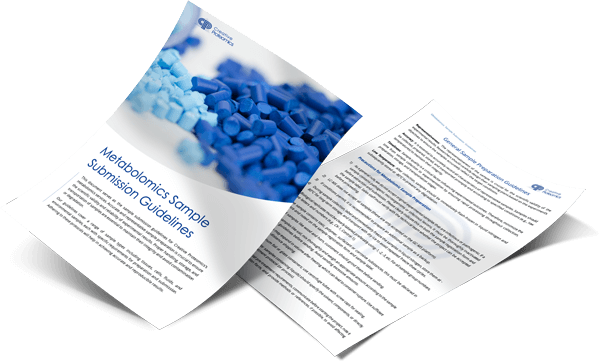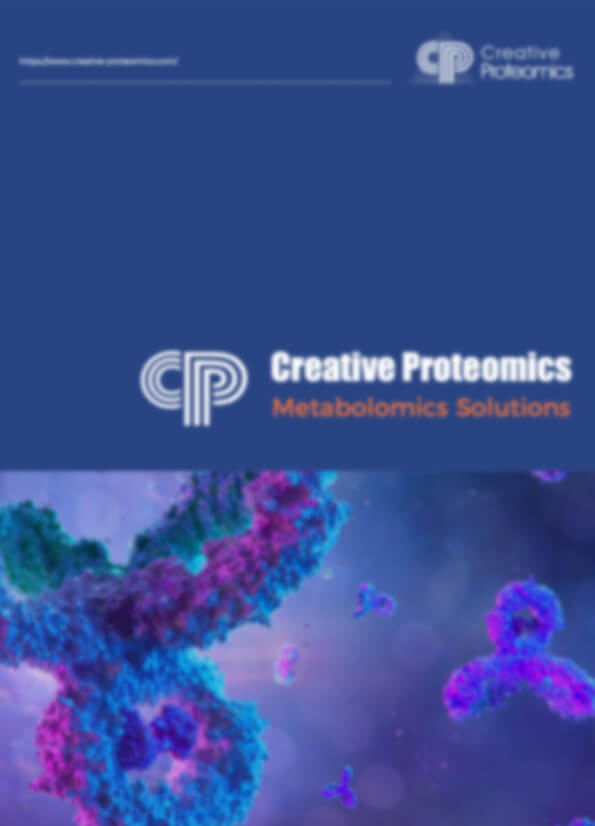Methylmalonic Acid Analysis Service
Accurate measurement of methylmalonic acid (MMA) is essential for uncovering mitochondrial dysfunction and vitamin B12 deficiency. At Creative Proteomics, we deliver high-precision, customizable LC-MS/MS-based MMA detection services—empowering your research with trusted data and fast turnaround times.
We Provide:
- Ultra-sensitive LC-MS/MS quantification down to 0.5 ng/mL
- Custom panels for B12 metabolism and mitochondrial pathway analysis
- Full matrix coverage: plasma, serum, urine, tissue, cells
- Rapid throughput: 150+ samples/day with ≤5% CV
- Detailed, publication-ready reports in PDF/Excel
Get the data you need—faster, more accurately, and ready for discovery.
Submit Your Request Now
×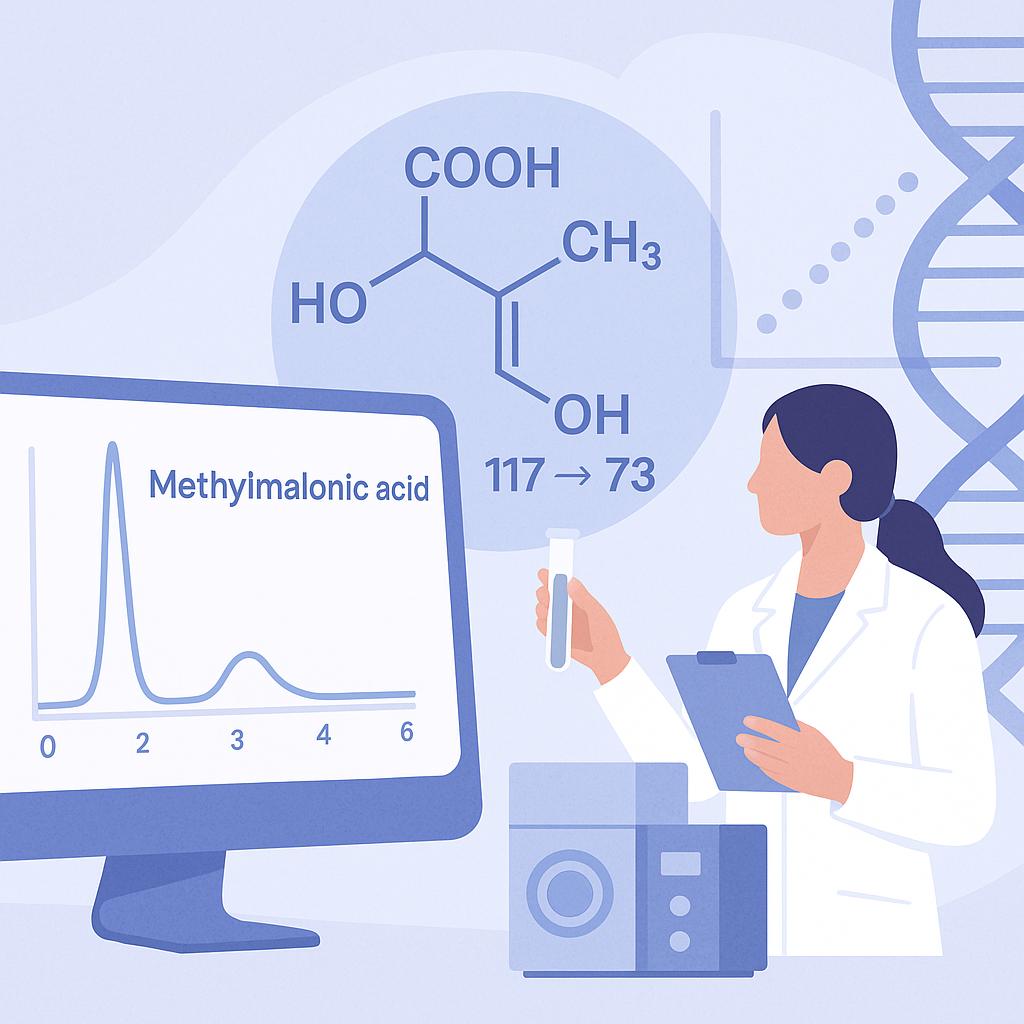
What You Receive:
- Raw and processed LC-MS/MS data (PDF & Excel)
- 7-point calibration curve (0.5–10,000 ng/mL)
- QC reports with recovery and CV values
- Full metabolite profile (MMA & related compounds)
- Optional statistical analysis upon request
- What We Provide
- Advantages
- Technology Platform
- Sample Requirement
- Demo
- FAQ
What is Methylmalonic Acid?
Methylmalonic acid (MMA) is a small dicarboxylic acid that serves as a key intermediate in the mitochondrial catabolism of certain amino acids and odd-chain fatty acids. As a functional marker of the cobalamin-dependent enzyme methylmalonyl-CoA mutase, MMA is widely used in metabolic research to reflect mitochondrial function and disruptions in vitamin B12-related pathways. Its quantification is critical in studies involving metabolic disorders, nutritional deficiencies, and biochemical pathway validation.
 Figure 1. The methylmalonic acid metabolism.
Figure 1. The methylmalonic acid metabolism.
Creative Proteomics's Methylmalonic Acid Analysis Solutions
Creative Proteomics delivers specialized LC-MS/MS-based methylmalonic acid (MMA) quantification services optimized for biomedical and metabolomics research. Our platform supports precise, high-throughput detection of MMA across a wide range of biological matrices with full customization.
Our MMA detection service includes:
- Quantitative detection of MMA in serum, urine, plasma, tissue, and cell samples
- Simultaneous profiling of MMA and related metabolites in metabolic pathways
- Custom panel design for MMA in vitamin B12-related or mitochondrial function studies
- Time-course and dose-response analysis for compound effect evaluation
- Batch analysis for large population or animal model studies
- Tailored sample preparation protocols to optimize recovery and sensitivity
- Flexible data output formats to meet academic or industrial requirements
Our solutions are adaptable across different experimental designs, ensuring research continuity and data reproducibility.
Designed Around Your Research Goals
Whether you're conducting targeted metabolite profiling, screening for biomarkers related to vitamin B12 metabolism, or validating mitochondrial pathway function, Creative Proteomics provides fully customizable MMA detection solutions.
Applications we support:
- Mitochondrial metabolism and propionyl-CoA pathway research
- Cobalamin (vitamin B12) function and deficiency evaluation
- Nutritional, biochemical, and enzymatic activity studies
- Biomarker discovery and translational metabolomics
- Drug response or compound efficacy analysis in preclinical studies
Our analytical team works directly with clients to define method parameters, optimize sensitivity, and ensure robust, publication-ready data output.
What Methylmalonic Acid Can We Detect?
| Analyte Name | Abbreviation | Biological Relevance |
|---|---|---|
| Methylmalonic Acid | MMA | Key biomarker of impaired methylmalonyl-CoA to succinyl-CoA conversion |
| Methylmalonyl-CoA | — | Direct precursor to MMA; accumulates when B12-dependent mutase is deficient |
| Succinyl-CoA | — | TCA cycle intermediate; product of MMA conversion |
| Propionyl-CoA | — | Upstream precursor in the propionate metabolism pathway |
| Propionylcarnitine | C3 | Indicator of mitochondrial propionate overload |
| 2-Methylcitric Acid | MCA | Alternative metabolic product when MMA accumulates |
| Cobalamin (Vitamin B12) | B12 | Essential cofactor for methylmalonyl-CoA mutase |
| Adenosylcobalamin | AdoCbl | Active form of B12 used by methylmalonyl-CoA mutase |
| Cyanocobalamin | CNCbl | Synthetic form of vitamin B12, often monitored in supplementation studies |
| Hydroxocobalamin | OHCbl | Natural B12 analog involved in cobalamin metabolism |
| Homocysteine | Hcy | Elevated levels may compete for B12 metabolism and affect methylation cycles |
| Methionine | Met | Substrate in methylation pathways influenced by B12 status |
| S-Adenosylmethionine | SAM | Central methyl donor in biochemical methylation reactions |
| S-Adenosylhomocysteine | SAH | Product of SAM demethylation; methylation balance indicator |
| Glutaric Acid | GA | Structurally similar to MMA; used to rule out organic acidurias |
| Succinic Acid | SA | TCA cycle intermediate, can be mistaken for MMA if not properly separated |
| Lactic Acid | LA | General mitochondrial dysfunction marker |
| Fumaric Acid | FA | Downstream TCA intermediate; part of energy metabolism assessment |
Advantages of Our Methylmalonic Acid Analysis Services
- Ultra-Sensitive Detection: Achieves a limit of detection (LOD) as low as 0.5 ng/mL, enabling reliable quantification even in trace-level samples.
- Wide Quantification Range: Linear detection spanning from 0.5 ng/mL to 10,000 ng/mL, suitable for diverse sample types and concentration levels.
- High Precision and Accuracy: Intra- and inter-assay coefficients of variation (CV) below 5%, ensuring consistent and reproducible results.
- Stable Isotope-Labeled Standards: Utilization of isotope-labeled MMA internal standards results in recovery rates above 98%, minimizing matrix effects and enhancing quantification accuracy.
- Broad Matrix Compatibility: Validated protocols for plasma, serum, urine, tissue, and cell lysates provide flexible sample handling options.
- Rapid Throughput: Capability to process over 150 samples per day, supporting large-scale studies without compromising data quality.
- High Specificity: LC-MS/MS technology effectively separates MMA from isobaric and structurally similar compounds, reducing analytical interference.
- Comprehensive Data Reporting: Detailed reports include calibration curves, QC results, and raw data files to support further analysis and publication requirements.
Workflow for Methylmalonic Acid Analysis Service
1. Project Setup
Clarify sample type, detection range, and analytical goals. Customized method planning based on research needs.
2. Sample Check-In
All samples undergo volume, labeling, and condition verification. Logged into LIMS for full traceability.
3. Sample Preparation
Matrix-specific protocols: deproteinization, extraction, and addition of stable isotope-labeled MMA internal standards for quant accuracy.
4. LC-MS/MS Analysis
Performed on UHPLC–AB Sciex 6500+ Triple Quadrupole system.
- Negative ESI mode
- MRM transitions: MMA m/z 117→73; MMA-d3 m/z 120→76
- Run time: ~6 minutes/sample
- LOD: ≤0.5 ng/mL
5. Quantification & QC
7-point calibration curve (0.5–10,000 ng/mL) with R² > 0.995. QC samples evaluated for recovery, precision (CV < 5%).
6. Data Reporting
Results provided in PDF/Excel format, including concentrations, calibration data, and QC metrics. Additional statistical analysis available on request.

Technology Platform for Methylmalonic Acid Analysis Service
Liquid chromatography-tandem mass spectrometry (LC-MS/MS)
- Instrument: AB Sciex Triple Quad™ 6500+ LC-MS/MS system
- Chromatography: Ultra-high-performance liquid chromatography (UHPLC) using an Agilent 1290 Infinity II system
- Column: Waters ACQUITY UPLC BEH C18 (2.1 × 100 mm, 1.7 μm particle size)
- Mobile Phase: Gradient elution with water (0.1% formic acid) and acetonitrile (0.1% formic acid)
- Flow Rate: 0.3 mL/min
- Injection Volume: 5 µL
- Ionization Mode: Negative electrospray ionization (ESI-)
- MRM Transitions:
- MMA: m/z 117.0 → 73.0
- Stable isotope-labeled MMA internal standard (e.g., MMA-d3): m/z 120.0 → 76.0
- Limit of Detection (LOD): ≤0.5 ng/mL
- Calibration Range: 0.5 ng/mL to 10,000 ng/mL with linearity R² > 0.995
For specific cases requiring complementary analysis, gas chromatography-mass spectrometry (GC-MS) using an Agilent 7890B GC coupled with a 7000D MS detector is available, leveraging derivatization techniques to improve volatility and detection sensitivity.
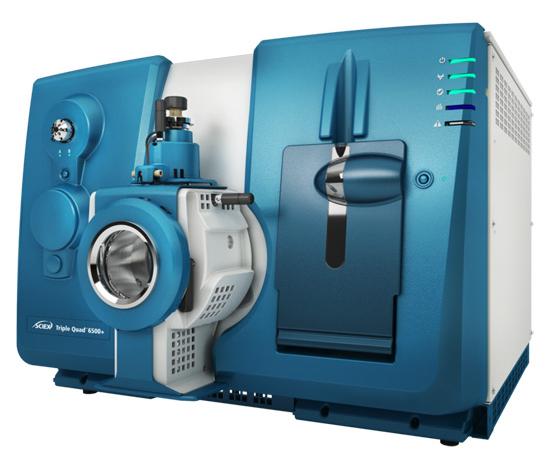 SCIEX Triple Quad™ 6500+ (Figure from Sciex)
SCIEX Triple Quad™ 6500+ (Figure from Sciex)
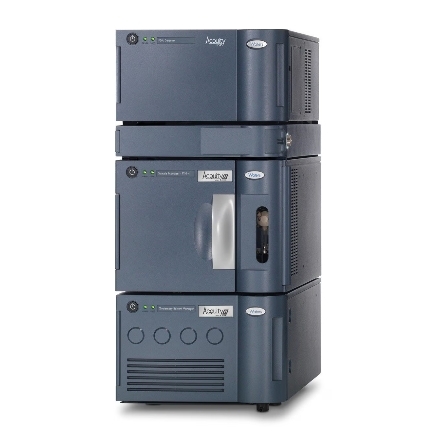 Waters ACQUITY UPLC System (Figure from Waters)
Waters ACQUITY UPLC System (Figure from Waters)
Sample Requirements for Methylmalonic Acid Analysis Service
| Sample Type | Recommended Volume | Collection Container | Storage Conditions | Notes |
|---|---|---|---|---|
| Plasma | 200–500 µL | EDTA or heparin anticoagulant tube | Store at -80°C; avoid freeze-thaw cycles | Use freshly collected or properly frozen samples |
| Serum | 200–500 µL | Serum separator tube (SST) | Store at -80°C; avoid freeze-thaw cycles | Allow clotting before centrifugation |
| Urine | 5–10 mL | Sterile polypropylene container | Store at -20°C or below | Midstream clean catch preferred |
| Dried Blood Spots (DBS) | Minimum 3 spots | Special filter paper card | Store in a sealed bag with desiccant at room temperature or -20°C | Avoid humidity and direct sunlight |
| Tissue (e.g., liver) | ≥50 mg | Cryovials | Snap freeze in liquid nitrogen, store at -80°C | Provide homogenized or frozen tissue |
Notes:
- Avoid repeated freeze–thaw cycles to prevent degradation.
- Maintain samples under inert gas (e.g., N₂ or Ar) for long-term storage.
- Ship samples on dry ice with appropriate labeling.
Demo Results
FAQ of Methylmalonic Acid Analysis Service
Can I send previously collected samples, or do they need to be freshly prepared?
Yes, previously collected samples are accepted as long as they have been properly stored (e.g., at -80°C) and have not undergone repeated freeze–thaw cycles. We'll review your sample integrity upon arrival.
Do you support pilot studies or small-batch testing before committing to large-scale analysis?
Yes. We offer flexible packages for feasibility studies or pilot runs, which are ideal for method validation or initial screening before scaling up.
Is metabolite stability a concern during shipping?
MMA is generally stable under proper storage, but we recommend shipping samples on dry ice and minimizing transit time. We also provide pre-labeled sample kits and shipping guidelines upon request.
Can your service be integrated into clinical trial workflows or preclinical pipelines?
Yes. While our MMA assay is for research use only, it is fully compatible with preclinical workflows, dose-response studies, and exploratory biomarker validation in clinical trial phases.
Do you offer custom bioinformatic or pathway enrichment analysis based on MMA data?
We provide optional statistical analysis and can support integration with pathway enrichment tools upon request. Let us know your study goals, and we'll tailor the output to your data needs.
Are there volume-saving options for rare or low-quantity samples?
Yes. Our methods are miniaturizable for low-input samples such as pediatric plasma, CSF, or fine-needle tissue extracts. Contact us for ultra-low volume protocol options.
How do I know if methylmalonic acid testing is right for my study?
If your research involves vitamin B12 metabolism, mitochondrial function, or propionate pathway disorders, MMA is a well-established and sensitive metabolic indicator. Our scientists can help assess fit based on your study design.
Can you accommodate urgent or time-sensitive research needs?
While we avoid rush processing to maintain quality, expedited projects can be discussed individually. Let us know your deadlines, and we'll work to support your timeline.
Do you support multi-site collaboration or blinded sample analysis?
Yes. We can manage multi-center sample tracking, blinded analysis, and randomized batch processing. Custom workflows are available for consortium or CRO-style projects.
Is method transfer or co-development possible if we plan to internalize the assay later?
Yes. For long-term partners, we offer method transfer support, SOP documentation, and training consultation so you can reproduce the assay in-house when needed.
Learn about other Q&A about proteomics technology.
Publications
Here are some of the metabolomics-related papers published by our clients:

- A human iPSC-derived hepatocyte screen identifies compounds that inhibit production of Apolipoprotein B. 2023.
- The activity of the aryl hydrocarbon receptor in T cells tunes the gut microenvironment to sustain autoimmunity and neuroinflammation. 2023.
- Lipid droplet-associated lncRNA LIPTER preserves cardiac lipid metabolism. 2023.
- Inflammation primes the kidney for recovery by activating AZIN1 A-to-I editing. 2023.
- Anti-inflammatory activity of black soldier fly oil associated with modulation of TLR signaling: A metabolomic approach. 2023.
- Plant Growth Promotion, Phytohormone Production and Genomics of the Rhizosphere-Associated Microalga, Micractinium rhizosphaerae sp. 2023.


